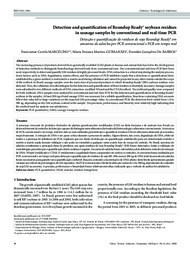Detection and quantification of Roundup Ready soybean residues in sausage samples by conventional and real-time PCR.
Detection and quantification of Roundup Ready soybean residues in sausage samples by conventional and real-time PCR.
Author(s): MARCELINO, F. C.; GUIMARÃES, M. F. M.; BARROS, E. G.
Summary: The increasing presence of products derived from genetically modified (GM) plants in human and animal diets has led to the development of detection methods to distinguish biotechnology-derived foods from conventional ones. The conventional and real-time PCR have been used, respectively, to detect and quantify GM residues in highly processed foods. DNA extraction is a critical step during the analysis process. Some factors such as DNA degradation, matrix effects, and the presence of PCR inhibitors imply that a detection or quantification limit, established for a given method, is restricted to a matrix used during validation and cannot be projected to any other matrix outside the scope of the method. In Brazil, sausage samples were the main class of processed products in which Roundup Ready® (RR) soybean residues were detected. Thus, the validation of methodologies for the detection and quantification of those residues is absolutely necessary. Sausage samples were submitted to two different methods of DNA extraction: modified Wizard and the CTAB method. The yield and quality were compared for both methods. DNA samples were analyzed by conventional and real-time PCR for the detection and quantification of Roundup Ready® soybean in the samples. At least 200 ng of total sausage DNA was necessary for a reliable quantification. Reactions containing DNA amounts below this value led to large variations on the expected GM percentage value. In conventional PCR, the detection limit varied from 1.0 to 500 ng, depending on the GM soybean content in the sample. The precision, performance, and linearity were relatively high indicating that the method used for analysis was satisfactory.
Publication year: 2008
Types of publication: Journal article
Unit: Embrapa Dairy Cattle
Keywords: GMO, PCR quantitative, Sausage, Transgenic residues
Observation
Some of Embrapa's publications are published as ePub files. To read them, use or download one of the following free software options to your computer or mobile device. Android: Google Play Books; IOS: iBooks; Windows and Linux: Calibre.
Access other publications
Access the Agricultural Research Database (BDPA) to consult Embrapa's full library collection and records.
Visit Embrapa Bookstore to purchase books and other publications sold by Embrapa.

